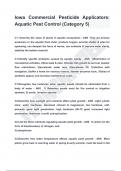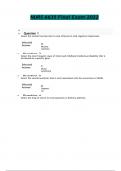Exam (elaborations)
Iowa Commercial Pesticide Applicators: Aquatic Pest Control (Category 5) QUESTIONS & ANSWERS 2024 ( A+ GRADED 100% VERIFIED)
- Course
- Institution
Iowa Commercial Pesticide Applicators: Aquatic Pest Control (Category 5) QUESTIONS & ANSWERS 2024 ( A+ GRADED 100% VERIFIED)
[Show more]




